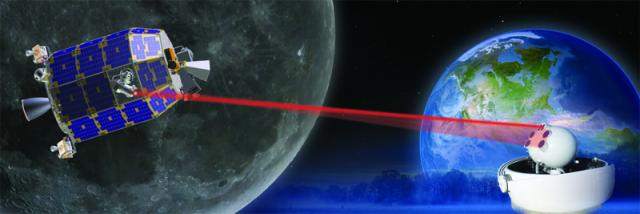Apparently, my U-verse rep is right, getting Internet access is rocket science and I should stop screaming at him. As for its Lunar Laser Communication Demonstration (LLCD), NASA has demonstrated a new record for data transmission using lasers. Communicating with laser sounds so cool, dude!
LLCD used a pulsed laser beam to transmit data across the 239,000 miles between the moon and Earth at a rate of 622 Mbps. LLCD is NASA’s first system for two-way communication using a laser instead of radio waves. It also has demonstrated an error-free data upload rate of 20 Mbps transmitted from the primary ground station in New Mexico to the spacecraft currently orbiting the moon.
“LLCD is the first step on our roadmap toward building the next generation of space communication capability,” said Badri Younes, NASA’s deputy associate administrator for space communications and navigation (SCaN) in Washington.

Since NASA first ventured into space, it has relied on radio frequency (RF) communication. However, RF is reaching its limit as demand for more data capacity continues to increase. The development and deployment of laser communications will enable NASA to extend communication capabilities such as increased image resolution and 3D video transmission from deep space.
LLCD is a short-term experiment; NASA’s long-duration demonstration, the Laser Communications Relay Demonstration (LCRD) is a part of the agency’s Technology Demonstration Missions Program, which is working to develop crosscutting technology capable of operating in the rigors of space. It is scheduled to launch in 2017.
LLCD is hosted aboard NASA’s Lunar Atmosphere and Dust Environment Explorer (LADEE), launched in September from NASA’s Wallops Flight Facility on Wallops Island, Va. LADEE is a 100-day robotic mission operated by the agency’s Ames Research Center at Moffett Field, Calif. LADEE’s mission is to provide data that will help NASA determine whether dust caused the mysterious glow astronauts observed on the lunar horizon during several Apollo missions. It also will explore the moon’s atmosphere. Ames designed, developed, built, integrated and tested LADEE, and manages overall operations of the spacecraft.
The LLCD system, flight terminal and primary ground terminal at NASA’s White Sands Test Facility in Las Cruces, N.M., were developed by the Lincoln Laboratory at MIT. The Table Mountain Optical Communications Technology Laboratory operated by NASA’s Jet Propulsion Laboratory in Pasadena, Calif., is participating in the demonstration. A third ground station operated by the European Space Agency on Tenerife in the Canary Islands also will be participating in the demonstration.






